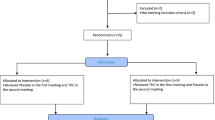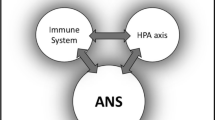Abstract
Carrageenin-induced pedal inflammation in rats, was found to significantly enhance brain levels of prostaglandin (PG) E2 and PGF2α. PG levels increased after 30 min of induction of the inflammation, peaked at 1 h, and attained normal levels by 4 h. Bilateral adrenalectomy had little effect on carrageenin-induced increase in rat brain PGs. The pattern of elevation of central PGs and the time course of carrageenin inflammation were at variance, the latter peaking between 3 and 4 h.
The findings lend credence to the postulate that inflammatory hyperalgesia involves participation of central pain circuits, and that fever accompanying inflammation is caused by the central release of PGs. The central nociceptive and hyperthermic actions of PGs are well documented. However, the increase in central PG levels may well be caused by stress induced by the peripheral inflammation, since the pattern of elevation in either case is qualitatively similar.
Similar content being viewed by others
References
Bhattacharya S. K. (1982) Stress by restraining elevates brain prostaglandins in the rat.Neurosci. Lett. 33, 165–168.
Bhattacharya S. K. and Das N. (1984) Effect of central prostaglandins on carrageenin-induced pedal oedema in rats.J. Pharm. Pharmacol. (in Press).
Bito L. Z. and Davson H. (1974) Carrier mediated removal of prostaglandins from cerebrospinal fluid.J. Physiol. (Lond.)236, 39–40 P.
Bito L. Z., Davson H., and Hollingsworth, J. R. (1976) Facilitated transport of prostaglandins across the blood-cerebrospinal fluid and blood-brain barriers.J. Physiol. (Lond.)256, 273–285.
Cooper S. A. (1981) Comparative analgesic efficacies of aspirin and acetaminophen.Arch. Intern. Med. 141, 293–300.
Coceani F. and Pace-Asciak C. R. (1976) Prostaglandins and the central nervous system, inProstaglandins: Physiological, Pharmacological and Pathological Aspects (Karim S. M. M., ed.) p. 1, MTP Press, Lancaster.
Das N. and Bhattacharya S. K. (1984) Central catecholaminergic modulation of carrageenin-induced inflammation in rats.Can. J. Neurol. Sci. (communicated).
Das N., Das P. K., and Bhattacharya S. K. (1983) Central modulation of peripheral inflammation in albino rats.Ind. J. Pharmacol. 15, 64–65.
Ferreira S. H. (1979) Participation of prostaglandins in inflammatory pain, inAdvances in Pharmacology and Therapeutics, Vol. 4:Prostaglandins-Immunopharmacology (Vargaftig, B. B., ed.) pp. 63, Pergamon Press, New York.
Ferreira S. H., Lorenzetti B. B., and Correa F. M. A. (1978) Central and peripheral antialgesic action of aspirin-like drugs.Eur. J. Pharmacol. 53, 39–48.
Ferri S., Santagostino A., Braga P. C., and Galatulas I. (1974) Decreased antinociceptive effect of morphine in rats treated intraventricularly with prostaglandin E1.Psychopharmacologia 39, 231–235.
Flower R. J. (1974) Drugs which inhibit prostaglandin biosynthesis.Pharmacol. Rev. 26, 33–67.
Flower, R. J. (1978) Prostaglandins and related compounds, inHandbook of Experimental Pharmacology, Vol. 50/1:Inflammation (Vane J. R. and Ferreira S. H., eds.) pp. 374, Springer-Verlag, New York.
Flower R. J. and Vane J. R. (1972) Inhibition of prostaglandin synthetase in brain explains the antipyretic activity of paracetamol (4-acetamido-phenol).Nature (Lond.)240, 410–411.
Granstrom E. and Kindahl H. (1978) Radioimmunoassay for prostaglandins and thromboxanes, inAdvances in Prostaglandin and Thromboxane Research (Frolich, J. C., ed.) pp. 119, Raven Press, New York.
Moncada S., Ferreira S. H., and Vane J. R. (1975) Inhibition of prostaglandin biosynthesis as the mechanism of analgesia of aspirin-like drugs in the dog knee joint.Eur. J. Pharmacol. 31, 250–260.
Steinhauer H. B., Anhut H., and Hertting G. (1980) Stress-induced increase of prostaglandin synthesis in mouse brain, inCatecholamines and Stress: Recent Advances (Usdin E., Kvetnansky R., and Kopin I. J., eds.) pp. 101, Elsevier North Holland, New York.
Vane J. R. (1971) Inhibition of prostaglandin synthesis as a mechanism of action for aspirin-like drugs.Nature (New Biol.)231, 232–235.
Winter C. A., Risley E. A., and Nuss G. W. (1962) Carrageenin-induced edema in the hind paw of rat as an assay for anti-inflammatory drugs.Proc. Soc. Exp. Biol. 111, 544–547.
Author information
Authors and Affiliations
Rights and permissions
About this article
Cite this article
Bhattacharya, S.K., Das, N. Effect of carrageenin-induced pedal edema on rat brain prostaglandins. Neurochemical Pathology 2, 163–169 (1984). https://doi.org/10.1007/BF02834350
Received:
Accepted:
Issue Date:
DOI: https://doi.org/10.1007/BF02834350
Index Entries
- Carrageenin, effect of edema induced by, on brain prostaglandins
- pedal inflammation, effect on brain prostaglandins by carrageenin-induced
- rat brain prostaglandins, effect of carrageenin-induced pedal inflammation on
- edema, effect on brain prostaglandins by carrageenin-induced
- prostaglandins, effect of carrageenin-induced edema on brain
- brain prostaglandins, effect of carrageenin-induced edema on




